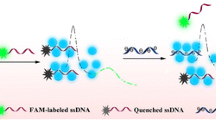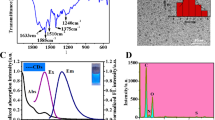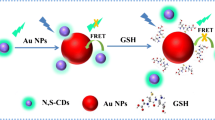Abstract
Carbon dots as new nanomaterials, have been widely used in rapid detection because of their nondestructive, real-time detection characteristics. Improving the sensitivity and selectivity of the method in complex real samples is new challenge and requirement for sensing technology. Here, we report an ultrasensitive fluorescence immunoassay (FIA) for trace diethyl phthalate (DEP) using red carbon dots@SiO2 (R-CDs@SiO2) as tags. SiO2 as a nanocarrier can effectively improve the bio-functionalization and utilization rate of carbon dots. Moreover, several R-CDs embedded in SiO2 nanospheres can magnify the fluorescence signal and improve sensitivity. R-CDs@SiO2 conjugate anti-DEP antibody (Ab) as fluorescent immunosensor, which can specifically recognize DEP. Under optimization conditions, the detection limit (LOD) of this FIA was calculated as 0.0011 ng/mL. In addition, the recoveries of this established FIA ranged from 96.8 to 108.5%, showing satisfactory accuracy. Compared with GC-MS/MS (LOD µg/mL), the sensitivity of the FIA was significantly improved. As a result, the FIA developed using R-CDs@SiO2 as tags has a high potential for determining trace DEP.







Similar content being viewed by others
Data Availability
The datasets generated during and/or analyzed during the current study are available from the corresponding author on reasonable request.
References
Wang XM, Chen C, Xu LH et al (2019) Development of molecularly imprinted biomimetic immunoassay method based on quantum dot marker for detection of phthalates. Food Agric Immunol 30(1):1007–1019. https://doi.org/10.1080/09540105.2019.1649371
Xu ZL, Ye SL, Luo L et al (2020) Fluorescent enzyme-linked immunoassay based on silane-doped carbon dots for sensitive detection of microcystin-LR in water and crucian samples. Sci Total Environ 708(134614). https://doi.org/10.1016/j.scitotenv.2019.134614
Wang Y, Li L, Li H et al (2021) A fluorometric sandwich biosensor based on rationally imprinted magnetic particles and aptamer modified carbon dots for the detection of tropomyosin in seafood products. Food Control 108552. https://doi.org/10.1016/j.foodcont.2021.108552
Yan C, Wang C, Hou T et al (2021) Lasting Tracking and Rapid discrimination of live gram-positive Bacteria by Peptidoglycan-Targeting Carbon Quantum Dots. ACS Appl Mater Inter 13(1):1277–1287. https://doi.org/10.1021/acsami.0c19651
Su W, Guo R, Yuan F et al (2020) Red-Emissive Carbon Quantum Dots for Nuclear Drug Delivery in Cancer Stem cells. J Phys Chem Lett 11(4):1357–1363. https://doi.org/10.1021/acs.jpclett.9b03891
Li L, Lian ZY, Yan X et al (2018) An evaporation induced self-assembly approach to prepare polymorphic carbon dot fluorescent nanoprobes for protein labelling. Chem Commun (Camb) 54(93):13123–13126. https://doi.org/10.1039/c8cc05860a
Xiao P, Ke Y, Lu J et al (2018) Photoluminescence immunoassay based on grapefruit peel-extracted carbon quantum dots encapsulated into silica nanospheres for p53 protein. Biochem Eng J 139:109–116. https://doi.org/10.1016/j.bej.2018.08.012
Chen Y, Ma Q, Li Z et al (2020) An autocatalytic route of CuO/Co3O4@SiO2 nanocapsules as excellent performance supercapacitor materials. New J Chem 44(29):12430–12434. https://doi.org/10.1039/d0nj02356f
Kumar K, Kumar Doddi S, Arunasree MK et al (2015) CPMV-induced synthesis of hollow mesoporous SiO2 nanocapsules with excellent performance in drug delivery. Dalton Trans 44(9):4308–4317. https://doi.org/10.1039/c4dt02549k
Singh RK, Patel KD, Leong KW et al (2017) Progress in Nanotheranostics based on mesoporous silica Nanomaterial Platforms. ACS Appl Mater Inter 9(12):10309–10337. https://doi.org/10.1021/acsami.6b16505
Boyle MD, Kavi LK, Louis LM et al (2021) Occupational exposures to phthalates among black and Latina U.S. Hairdressers serving an ethnically diverse clientele: a pilot study. Environ Sci Technol 55(12):8128–8138. https://doi.org/10.1021/acs.est.1c00427
Norwegian Institute of, Public H, Gkrillas A, Dirven H et al (2020) Risk assessment of phthalates based on aggregated exposure from foods and personal care products and comparison with biomonitoring data. EFSA J 18:e181105. https://doi.org/10.2903/j.efsa.2020.e181105
Liu T, He L, Peng J et al (2022) Occurrence and dietary exposure risk assessment of phthalate esters in chinese mitten crabs (Eriocheir sinensis) from Hubei, central China. Food Control 133(108618). https://doi.org/10.1016/j.foodcont.2021.108618
Ranjan VP, Joseph A, Goel S (2021) Microplastics and other harmful substances released from disposable paper cups into hot water. J Hazard Mater 404(Pt B) 124118. https://doi.org/10.1016/j.jhazmat.2020.124118
Wu HT, Kupsco AJ, Deierlein AL et al (2020) Trends and patterns of phthalates and Phthalate Alternatives exposure in pregnant women from Mexico City during 2007–2010. Environ Sci Technol 54(3):1740–1749. https://doi.org/10.1021/acs.est.9b05836
Praveena SM, Fong CS, Amaruddin AF (2021) Phthalates in children Toys available in malaysian market: quantification and potential Human Health risk. J Steroid Biochem Mol Biol 105955. https://doi.org/10.1016/j.jsbmb.2021.105955
Golestanzadeh M, Riahi R, Kelishadi R (2020) Association of phthalate exposure with precocious and delayed pubertal timing in girls and boys: a systematic review and meta-analysis. Environ Sci Process Impacts 22(4):873–894. https://doi.org/10.1039/c9em00512a
Zhang JJ, Wang L, Trasande L et al (2021) Occurrence of polyethylene terephthalate and polycarbonate microplastics in infant and adult feces. Environ Sci Tech Let https://. doi:https://doi.org/10.1021/acs.estlett.1c00559
Erickson B (2021) TOXICOLOGY Congress urges reduction of phthalates in medical equipment. Chem Eng News 99(7):17–17. https://doi.org/10.1021/cen-09907-polcon3
Morse PM (2011) PHTHALATES FACE MURKY FUTURE. Chem Eng News 89(22):28–31. https://doi.org/10.1021/cen-v089n022.p028
Draviam EJ, Kerkay J, Pearson KH (2006) Separation and quantitation of urinary phthalates by HPLC. Anal Lett 13(13):1137–1155. https://doi.org/10.1080/00032718008055721
Insuan W, Khawmodjod P, Whitlow HJ et al (2016) High-throughput and low-cost analysis of Trace Volatile Phthalates in Seafood by Online Coupling of monolithic Capillary Adsorbent with GC-MS. J Agric Food Chem 64(16):3287–3292. https://doi.org/10.1021/acs.jafc.6b00742
Vavrous A, Sevcik V, Dvorakova M et al (2019) Easy and Inexpensive Method for Multiclass Analysis of 41 food contact related contaminants in fatty food by Liquid Chromatography-Tandem Mass Spectrometry. J Agric Food Chem 67(39):10968–10976. https://doi.org/10.1021/acs.jafc.9b02544
Sanchis A, Bosch-Orea C, Salvador JP et al (2019) Development and validation of a multianalyte immunoassay for the quantification of environmental pollutants in seawater samples from the Catalonia coastal area. Anal Bioanal Chem 411(22):5897–5907. https://doi.org/10.1007/s00216-019-01971-3
Shin J, Kasama T, Miyake R (2022) Development of cellulosic material-based microchannel device capable of fluorescence immunoassay of microsamples. Anal Bioanal Chem https://. doi:https://doi.org/10.1007/s00216-022-03963-2
Long F, Gu C, Gu AZ et al (2012) Quantum dot/carrier-protein/haptens conjugate as a detection nanobioprobe for FRET-based immunoassay of small analytes with all-fiber microfluidic biosensing platform. Anal Chem 84(8):3646–3653. https://doi.org/10.1021/ac3000495
Zhang J, Li T, Zhang T et al (2016) Receptor-based fluorescence polarization assay to detect Phthalate Esters in Chinese spirits. Food Anal Method 10(5):1293–1300
Zhang M, Cong Y, Sheng YL et al (2010) A direct competitive enzyme-linked immunosorbent assay by antibody coated for diethyl phthalate analysis. Anal Biochem 406(1):24–28. https://doi.org/10.1016/j.ab.2010.06.040
Li L, Yan X, Xia M et al (2022) Nanoparticle/Nanocarrier formulation as an Antigen: the immunogenicity and antigenicity of itself. Mol Pharm 19(1):148–159. https://doi.org/10.1021/acs.molpharmaceut.1c00704
Ding H, Wei JS, Zhong N et al (2017) Highly efficient Red-Emitting Carbon Dots with Gram-Scale yield for Bioimaging. Langmuir 33(44):12635–12642. https://doi.org/10.1021/acs.langmuir.7b02385
Liu X, Wang T, Lu Y et al (2019) Constructing carbon dots and CdTe quantum dots multi-functional composites for ultrasensitive sensing and rapid degrading ciprofloxacin. Sens Actuat B: Chem 289:242–251. https://doi.org/10.1016/j.snb.2019.03.094
Zhou D, Li D, Jing P et al (2017) Conquering Aggregation-Induced solid-state luminescence quenching of Carbon Dots through a Carbon Dots-Triggered silica gelation process. Chem Mater 29(4):1779–1787. https://doi.org/10.1021/acs.chemmater.6b05375
Wu SM, Chen J, Ai XX et al (2013) Detection of Escherichia coli in drugs with antibody conjugated quantum dots as immunofluorescence probes. J Pharm Biomed Anal 78–79:9–13. https://doi.org/10.1016/j.jpba.2013.01.005
Bai Z, Yan F, Xu J et al (2018) Dual-channel fluorescence detection of mercuric (II) and glutathione by down- and up-conversion fluorescence carbon dots. Spectrochim Acta A Mol Biomol Spectrosc 205:29–39. https://doi.org/10.1016/j.saa.2018.07.012
Yan F, Bai Z, Chen Y et al (2018) Ratiometric fluorescent detection of copper ions using coumarin-functionalized carbon dots based on FRET. Sens Actuat B: Chem 275:86–94. https://doi.org/10.1016/j.snb.2018.08.034
Yan F, Bai Z, Zu F et al (2019) Yellow-emissive carbon dots with a large Stokes shift are viable fluorescent probes for detection and cellular imaging of silver ions and glutathione. Mikrochim Acta 186(2):113. https://doi.org/10.1007/s00604-018-3221-8
Kumari R, Sahu SK (2020) Effect of Solvent-Derived highly luminescent Multicolor Carbon Dots for White-Light-Emitting Diodes and Water Detection. Langmuir 36(19):5287–5295. https://doi.org/10.1021/acs.langmuir.0c00631
Chen BR, Li L, Hu Y et al (2022) Fluorescence turn-on immunoassay of endocrine diethyl phthalate in daily supplies using red fluorescent carbon dots. Microchem J 178. https://doi.org/10.1016/j.microc.2022.107350
Sun RY, Zhuang HS (2015) An ultrasensitive gold nanoparticles improved real-time immuno-PCR assay for detecting diethyl phthalate in foodstuff samples. Anal Biochem 480:49–57. https://doi.org/10.1016/j.ab.2015.04.010
Zhang MC, Yu XN, Wang Y et al (2012) A highly sensitive indirect competitive enzyme-linked immunosorbent assay (ic-ELISA) by Antigen Coating for Diethyl Phthalate Analysis in Foods. Food Anal Method 6(4):1223–1228. https://doi.org/10.1007/s12161-012-9529-9
Sun RY, Zhuang HS (2015) Development of a highly sensitive biotin–streptavidin enzyme-linked immunosorbent assay for detecting diethyl phthalate based on a specific polyclonal antibody. Food Agric Immunol 26(5):746–760. https://doi.org/10.1080/09540105.2015.1027666
Tian X, Dong YQ, Wang YF et al (2015) Quantification of Diethyl Phthalate by a Rapid and homogenous fluorescence polarization immunoassay. Anal Lett 48(18):2843–2855. https://doi.org/10.1080/00032719.2015.1060600
Zhu F, Mao C, Du DL (2017) Time-resolved immunoassay based on magnetic particles for the detection of diethyl phthalate in environmental water samples. Sci Total Environ 601–602:723–731. https://doi.org/10.1016/j.scitotenv.2017.05.111
Funding
This research was supported by the National Natural Science Foundation of China (21175004), the Anhui provincial Natural Science Foundation (2108085MB68) and the University Synergy Innovation Program of Anhui Province (GXXT-2020-074).
Author information
Authors and Affiliations
Contributions
All authors contributed to the study conception and design. Material preparation, data collection and analysis were performed by Biru Chen, Lei Li, Bolin Liu, Qianqian Yang, Yue Hu. The first draft of the manuscript was written by Biru Chen. Supervision, writing-review and project administration were performed by Mingcui Zhang, and all authors commented on previous versions of the manuscript. All authors read and approved the final manuscript.
Corresponding author
Ethics declarations
Conflict of interest
The authors declared that they have no conflicts of interest.
Ethical Approval
This article does not any studies with human subjects.
Informed Consent
Not applicable.
Additional information
Publisher’s Note
Springer Nature remains neutral with regard to jurisdictional claims in published maps and institutional affiliations.
Electronic Supplementary Material
Below is the link to the electronic supplementary material.
Rights and permissions
Springer Nature or its licensor (e.g. a society or other partner) holds exclusive rights to this article under a publishing agreement with the author(s) or other rightsholder(s); author self-archiving of the accepted manuscript version of this article is solely governed by the terms of such publishing agreement and applicable law.
About this article
Cite this article
Chen, B., Li, L., Yang, Q. et al. Fluorescence Signal Amplification: Red Carbon Dots@SiO2-Induced Ultra-sensitive Immunoassay for Diethyl Phthalate. J Fluoresc 33, 487–495 (2023). https://doi.org/10.1007/s10895-022-03100-3
Received:
Accepted:
Published:
Issue Date:
DOI: https://doi.org/10.1007/s10895-022-03100-3




